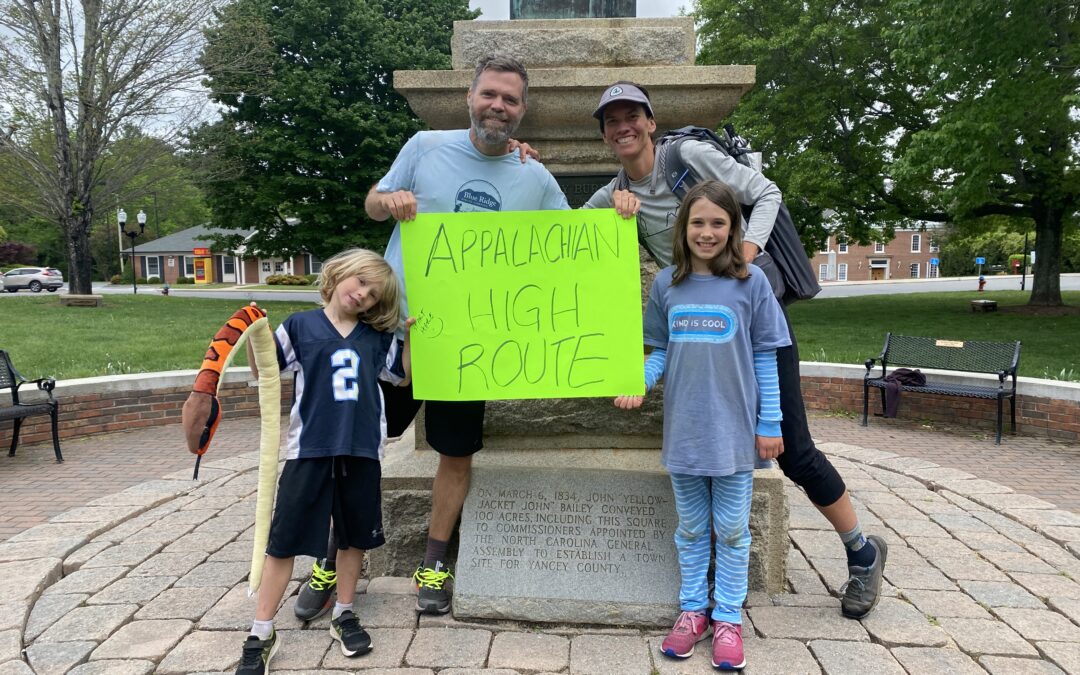If you follow me on social media, you know that for the past few years, I’ve been infatuated with wildflowers. I’ve sought them out in the Smokies, journaled about them, and posted on my “Wild Flower Wednesdays.” I’ve received tips from friends for nooks and crannies around Western North Carolina to spot rare jewels. I’ve learned about little brown jugs, bloodroot, trillium, trout lilies, pink lady slippers, and Solomon’s seal. I’ve read of their healing properties, and what the natives and early settlers used them for. It’s been a pursuit borne of love and one that I can’t say I expected when I began hiking nearly two decades ago. But it’s where my heart has been pulled.
One of the rarest wildflowers and the hardest to find has been the yellow lady slipper. A friend told me where I could see a cluster of them years ago on the Mountains to Sea Trail and I make my way back every year to check on my new friends. Another “lead” I got was for a city park in my hometown of Hendersonville, in an unlikely spot between the restrooms and the disc golf course. I was never able to find that one but did almost get clobbered by an errant tee shot.
Fast forward a couple of years to our new house on a wooded lot near downtown Asheville. We’ve lived here a year and a half and have enjoyed hiking the trails- and rabbit trails- in the nearby city park. Earlier this week, while I was out stretching my legs, I stumbled- miraculously- upon one of those coveted yellow lady slippers. It was less than 100 yards from our driveway. I couldn’t believe it. I was so excited to tell my husband Brew and share the good news with my fellow wildflower lovers on social media.
As excited as I am about that discovery, I’m even more excited to tell you about something else I’ve “discovered” in my own backyard. This spring, I’m partnering with the tourism bureau in Burnsville, North Carolina, to shine a light on their adorable town, its proximity to Mt. Mitchell (the tallest mountain east of the Mississippi), and the hundreds of miles of hiking trails that surround Burnsville in Yancey County.
The very first day I was being “onboarded” with die-hard hiker and Burnsville resident Jake Blood, as we pored over maps and discussed the nearby Appalachian Trail and Mountains-to-Sea Trail that run tantalizingly close to Burnsville, it hit us like a bolt of lightning. Simultaneously, sitting there in the visitor’s center, we realized… Burnsville and a newly established 19-mile corridor around it could be the linchpin for a new trail, a loop that runs 330 miles through the tallest peaks and highest ridgelines on the East Coast.
As of Mother’s Day, we are thrilled to announce the establishment of the Appalachian High Route, a trail that…
– Begins and ends at the Burnsville Visitor Center
– links the famed Appalachian Trail, Mountains to Sea Trail, and Black Mountain Crest Trail
– provides access to 50 of the 54 recognized peaks above 6,000 feet in the Appalachian Mountains
– connects Clingman’s Dome (the highest peak in the Great Smoky Mountain National Park and the highest point on the Appalachian Trail) with Mount Mitchell (the highest peak in the Black Mountain Range and the highest point in the Appalachians)
– also connects the story and history of Elisha Mitchell and Thomas Clingman, two very different men who argued about the prominence of these mountains and for whom the peaks are named
– fulfills the vision of Benton MacKaye (the originator of the Appalachian Trail) to connect the highest mountain in the Northeast (Mount Washington) with the highest mountain in the Southeast (Mount Mitchell)
– utilizes and connects the 30-mile Art Loeb Trail with the 11-mile Black Mountain Crest Trail, both renowned for their beauty and outstanding biodiversity
– Uses pre-existing trails in… three national park units (The Great Smoky Mountains National Park, The Blue Ridge Parkway, and The Appalachian National Scenic Trail), three national forests (Nantahala, Pisgah, and Cherokee), and one North Carolina state park (Mount Mitchell)
– offers resupplies in the trail towns of Burnsville, Hot Springs, and Asheville
– passes through the ancient and ancestral Qualla Boundary of the Eastern Band of Cherokee (EBCI)
– travels past other points of interest like… Lost Cove, the Folk Art Center near Asheville, Blue Ridge Parkway Visitor Center, the Biltmore Estate, Mount Mitchell Museum and Visitor Center, Craggy Gardens Visitors Center, Oconaluftee Visitor Center
This trail has the potential to bring thousands of long-distance hikers and visitors to Western North Carolina, fueling the economy of small towns in the area for years to come. I’m excited to be a part of it and humbled to champion it. I’m also honored to have been one of the first people to complete the trail (as of Mother’s Day!) with Haley Blevins Harmening, my good friend who is a Triple Crowner (Appalachian Trail, Pacific Crest Trail, Continental Divide Trail) and Burnsville resident.
So what’s the lesson? Yellow Ladyslipper. Appalachian High Route. Sometimes you travel far and wide looking for something of great value. Only to find it in your own backyard. Happy hunting.

